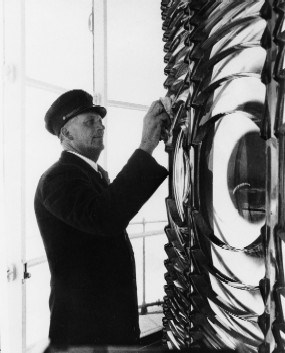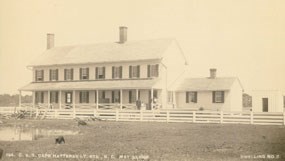|
The Keeper Over the years, the duties of the lightkeeper changed but the basic ones are as follows: 
NPS
Lighthouses could have anywhere from one to five keepers, depending on the size of the station. For example, as the Cape Hatteras light station grew, so did the number of staff. In 1803, there was only one keeper, though sometimes he hired someone to help with jobs around the station. With the improvements of 1854, an assistant keeper was officially hired. When the current lighthouse was completed in 1870, it was determined that a second assistant was needed. By the late 1870s, a third assistant had been hired to maintain the Cape Point beacon (a small light at the edge of Cape Point). So for a time, there were four keepers and their families living on the light station grounds. 
NPS Living at the Light Station The families at Cape Hatteras were lucky in many ways for they were not as isolated as other lighthouse families - on the grounds lived many people; nearby were the life-saving stations and their families; and down the road was the town of Buxton. The lighthouse’s last principal keeper, Unaka Jennette, was a native of Hatteras Island and was promoted to the position in 1919. He and his wife, Sudie, raised a family of seven at the station from 1919-1936. Their middle child, Rany, said that their childhood was anything but the stereotypical isolated existence of a lighthouse keeper. He recalled that the light station was often the focal point of the community, particularly during the summer months when the sea breezes didn’t reach into the woods where the native islanders lived. Rany remembered baseball, football, and “very competitive games of croquet” on the lighthouse grounds. He also recalled one Sunday afternoon when he and his father climbed the lighthouse 17 times to show visitors and friends. |
Last updated: April 23, 2025
